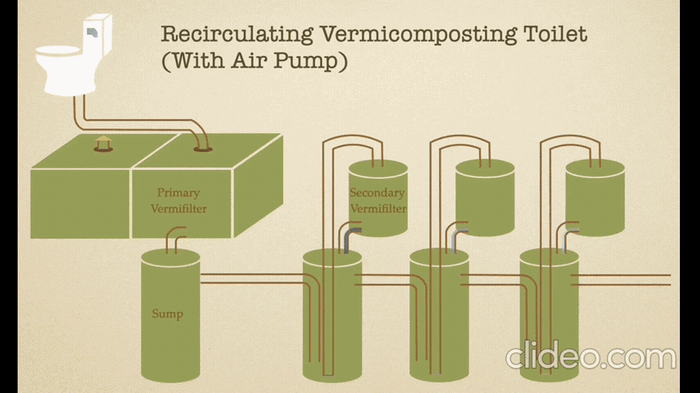
 4
4




Kimi BrownKawa
https://www.brownkawa.com




Iterations are fine, we don't have to be perfect
My 2nd Location:Florida HardinessZone:10 AHS:10 GDD:8500 Rainfall:2in/mth winter, 8in/mth summer, Soil:Sand pH8 Flat
 1
1




S Bengi wrote:I hope you are able to get it permitted. Maybe they will require that you call in a company to pump the "tank" after you plug the outlet pipe.
If you still can't get it permitted. Maybe you can have a IBC sized lift station that you then pump to your regular septic tank. It will just so happen that your lift station has woodchip in it.
Kimi BrownKawa
https://www.brownkawa.com
 1
1




John Daley Bendigo, Australia The Enemy of progress is the hope of a perfect plan
Benefits of rainfall collection https://permies.com/t/88043/benefits-rainfall-collection
GOOD DEBT/ BAD DEBT https://permies.com/t/179218/mortgages-good-debt-bad-debt




John C Daley wrote:I have seen a worm system as mentioned from Australia working well.
The owners report it does the job well as far as they are concerned.
John C Daley wrote: BUT they went away and the watchkeeper turned the power off to the system, killing the worms.
The power point or switch should have had a lock, but nobody thought of it at the time.
That of course could happen with any system.
Kimi BrownKawa
https://www.brownkawa.com
 1
1




 1
1




Amy Knutson wrote:Looking at the Solviva plans, Anna Edey uses effluent pumps, so it does require power. Is there a way to ensure the effluent runs through the beds without a pump?
Kimi BrownKawa
https://www.brownkawa.com








Burton Sparks wrote:Kimi, I'm working on a permit for a vermicomposting system as well. I've collected numerous technical papers and other information on the subject over the last couple of years as I've been putting together my application. Are you after just resources on the effectiveness of blackwater treatment using worm composting vs distribution methods, build materials, etc.? Or anything supporting the basic overall solviiva vermifilter type system end-to-end?
Kimi BrownKawa
https://www.brownkawa.com
















Burton Sparks wrote:Technical papers:
Arora, Sudipti & Kazmi, A.A.. (2015). The effect of seasonal temperature on pathogen removal efficacy of vermifilter for wastewater treatment. Water Research. 74C. 10.1016/j.watres.2015.02.001. Arora, Sudipti & Rajpal, Ankur & Kumar, Tarun & Bhargava, Renu & Kazmi, A.. (2014). Pathogen removal during wastewater treatment by vermifiltration. Environmental Technology. 10.1080/09593330.2014.911358. Arora, Sudipti & Rajpal, Ankur & Kumar, Tarun & Bhargava, Renu & Kazmi, A.. (2014). A comparative study for pathogen removal using different filter media during vermifiltration. Water Science & Technology. 70. 10.2166/wst.2014.318. Eastman, Bruce & Kane, Philip & Edwards, Clive & Trytek, Linda & Gunadi, Bintoro & Stermer, Andrea & Mobley, Jacquelyn. (2001). The Effectiveness of Vermiculture in Human Pathogen Reduction for USEPA Biosolids Stabilization. Compost Science & Utilization. 9. 10.1080/1065657X.2001.10702015. Furlong, Claire & Patankar, Rohit & Thakar, Gouri. (2015). The development of an onsite sanitation system based on vermifiltration: the ‘tiger toilet’. Journal of Water, Sanitation and Hygiene for Development. 10.2166/washdev.2015.167. Furlong, Claire & Templeton, M. & Gibson, W.. (2014). Processing of human faeces by wet vermifiltration for improved on-site sanitation. Journal of Water, Sanitation and Hygiene for Development. 4. 231. 10.2166/washdev.2014.107. Guruprasad, Anaokar. (2015). Design and Suitability of Modular Vermifilter for Domestic Sewage Treatment. 3. 44-51. Longmian Wang, Feihong Guo, Zheng Zheng, Xingzhang Luo, Jibiao Zhang, Enhancement of rural domestic sewage treatment performance, and assessment of microbial community diversity and structure using tower vermifiltration, Bioresource Technology, Volume 102, Issue 20, 2011, Pages 9462-9470, ISSN 0960-8524 Lourenço, Nelson & Nunes, Luis. (2017). Optimization of a vermifiltration process for treating urban wastewater. Ecological Engineering. 100. 138-146. 10.1016/j.ecoleng.2016.11.074. Rajneesh Singh, Kundan Samal, Rajesh Roshan Dash, Puspendu Bhunia, Vermifiltration as a sustainable natural treatment technology for the treatment and reuse of wastewater: A review, Journal of Environmental Management, Volume 247, 2019, Pages 140-151, ISSN 0301-4797
Additional helpful resources:
Edey, Anna. “Green Light at the End of the Tunnel.” Trailblazer Press, 2014 Edey, Anna. “Solviva: How to Grow $500,000 on One Acre & Peace on Earth.” Trailblazer Press, 2008. www.susana.org www.vermicompostingtoilets.net www.vermifilter.com World Health Organization, WHO Guidelines for the Safe use of Wastewater, Excreta and Greywater, Volume 1, Policy and Regulatory Aspects
Kimi BrownKawa
https://www.brownkawa.com
 4
4




Kimi Iszikala wrote:I am working on getting approval for a permitted vermicomposting septic system on our rural property in New Mexico.
Kimi BrownKawa
https://www.brownkawa.com




 1
1








Phil Stevens wrote:My PDC instructor, Gary Williams, also happens to be a water engineer and widely regarded as The Go-to Guy in this country for dealing with rivers and wetlands in a holistic manner. He managed to get council consent to install what might have been the first Wormorator system in NZ several years ago and got the ball rolling for others to follow. His system's output goes to a food forest with a pond basin at the bottom and the water at that point is well within tolerances for human contact (just not drinking quality).
Kimi BrownKawa
https://www.brownkawa.com

| I agree. Here's the link: http://stoves2.com |



